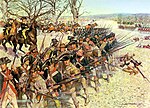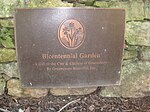Guilford Court House, North Carolina
Geography of Guilford County, North CarolinaGuilford County, North Carolina geography stubsLandmarks in North CarolinaUnited States history stubs
Guilford Court House, North Carolina, was the county seat of Guilford County before being replaced by Greensboro in 1808. It no longer exists as an identifiable community, having been absorbed by Greensboro. In 1781, it was the site of the Battle of Guilford Court House, which is now commemorated at Guilford Courthouse National Military Park. The Battle was between the Continental Army under general Nathanael Greene and the British Army under general Charles Cornwallis. The battle resulted in a British victory, but Greene's forces inflicted heavy casualties on Cornwallis' forces.
Excerpt from the Wikipedia article Guilford Court House, North Carolina (License: CC BY-SA 3.0, Authors).Guilford Court House, North Carolina
New Garden Road (historical), Greensboro
Geographical coordinates (GPS) Address Nearby Places Show on map
Geographical coordinates (GPS)
| Latitude | Longitude |
|---|---|
| N 36.1327425 ° | E -79.8422792 ° |
Address
New Garden Road (historical)
New Garden Road (historical)
27455 Greensboro
North Carolina, United States
Open on Google Maps





